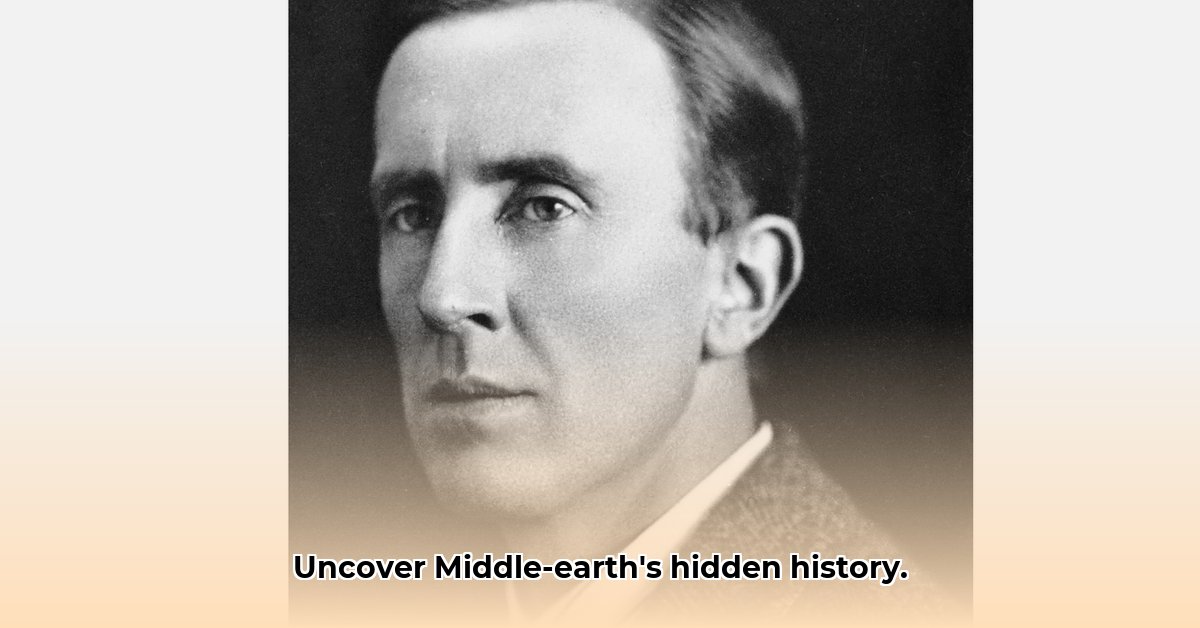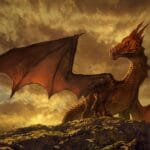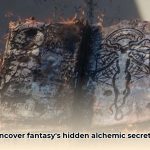Ever wondered where Tolkien’s magical world of Middle-earth actually came from? It wasn’t just pulled out of thin air; it’s deeply rooted in his own life, experiences, and academic passions. This exploration delves into the fascinating connection between Tolkien’s personal history – his childhood landscapes, his harrowing experiences in WWI, his profound love of languages and mythology – and the very fabric of Middle-earth: its landscapes, characters, cultures, and intricate languages. Discover how the serene beauty of the English countryside shaped the idyllic Shire, and how the industrial horrors of war influenced the bleak and terrifying Mordor. We’ll uncover how ancient myths and legends, particularly Norse and Celtic, echo throughout Tolkien’s stories, adding layers of depth and meaning. For more on mythical creature origins, see this article. Get ready for a journey into the real-life inspirations behind one of the most beloved and enduring fantasy worlds ever created.
The Historical Roots and Deep Inspiration Behind J.R.R. Tolkien’s Middle-earth Saga
Middle-earth, the iconic fantasy world masterfully crafted by J.R.R. Tolkien, wasn’t born from pure imagination alone. It’s a rich tapestry, intricately woven from the threads of Tolkien’s life, his profound experiences, and his deep academic passions for history, language, and mythology. Understanding these roots adds a new dimension to his incredible stories, enriching the experience for newcomers and offering fresh insights for lifelong fans. What pivotal moments and influences shaped the creation of this extraordinary world?
A Boy and His Landscapes: The Genesis of the Shire
Imagine a young J.R.R. Tolkien, spending his formative years in the rolling English countryside near Birmingham. He explored the picturesque Sarehole area, with its charming watermill, sparkling ponds teeming with swans, and gently sloping hills. This idyllic landscape became deeply embedded in his memory, profoundly influencing his later writing. Many believe that the tranquil beauty of the Shire, the beloved home of the hobbits in The Hobbit and The Lord of the Rings, directly reflects the calming landscapes of Tolkien’s childhood. The lush greenery, the gently flowing streams, and the quaint village life aren’t mere figments of imagination; they are echoes of his own cherished memories. This early experience of natural beauty provided a foundational contrast to the harsh realities he would later encounter during World War I. Could the serene and comforting atmosphere of the Shire be a direct reflection of Tolkien’s idyllic formative years in the English countryside?
The Great War’s Shadow: The Forging of Mordor’s Darkness and Despair
The First World War irrevocably altered the course of Tolkien’s life. His time on the Western Front, serving as a signals officer in the trenches, exposed him to the unprecedented horrors of modern warfare. He witnessed unimaginable suffering, loss, and the dehumanizing effects of industrialized combat, particularly during the Battle of the Somme in 1916. This undeniably traumatic experience profoundly influenced his creation of Mordor, the dark, desolate, and terrifying land ruled by Sauron. The bleakness, despair, and oppressive atmosphere of the war are mirrored in Mordor’s volcanic landscape, a stark visualization of the brutal conflict he endured. The sheer scale of death and destruction he witnessed likely shaped his understanding of the devastating cost of war and the unwavering spirit required to overcome seemingly insurmountable evil, a central theme throughout The Lord of the Rings. Some literary historians suggest that the relentless pressure, grim conditions, and psychological toll of trench warfare significantly impacted his depiction of protracted struggles against overwhelming odds. Did the industrial horrors and moral ambiguities of WWI directly inspire the grim landscapes and pervasive evil of Mordor, showcasing the profound and lasting impact of war on Tolkien’s imagination?
The Magic of Language: Crafting Realism into Middle-earth Linguistics
Tolkien wasn’t solely a storyteller; he was a world-class linguist and philologist, possessing an unparalleled understanding of language evolution and structure. He didn’t simply invent names for his fictional races; he meticulously crafted entire languages, like Quenya and Sindarin, endowing them with intricate grammar, extensive vocabularies, and detailed histories. This wasn’t a mere creative detail; it imbued Middle-earth with an unparalleled sense of depth, realism, and cultural authenticity. The languages themselves became living testaments to the rich histories and distinct cultures of the Elves, enabling them to seem less like fictional beings and more like societies with centuries of tradition and unique cultural identities. His dedication to linguistic detail makes Middle-earth feel incredibly real and believable, a testament to his profound academic skill and artistic vision. Approximately how many languages did Tolkien develop for Middle-earth, demonstrating the extraordinary scope of his linguistic genius?
Myths and Legends: Ancient Echoes Resonating in Middle-earth
Tolkien’s passion extended far beyond his personal experiences. He possessed an immense and scholarly love for mythology and folklore, particularly Norse sagas, Finnish epics like the Kalevala, and Celtic legends like the Mabinogion. These ancient tales, brimming with gods, heroes, epic battles, and moral complexities, served as a rich wellspring of inspiration for Middle-earth’s history, mythology, and thematic depth. These stories, transmitted and transformed across generations, profoundly shaped the narratives and fundamental structure of his fictional world. Many scholars believe that Tolkien’s deep understanding of these ancient narratives allowed him to craft a world that feels both timeless and refreshingly original. The epic battles between good and evil, the struggles against fate, the intricate family histories, and the pervasive sense of ancient grandeur all reflect the archetypes and recurring themes found within these enduring legends. What specific elements from Norse sagas and Celtic legends resonate most strongly within Middle-earth, and how do they contribute to its unique atmosphere and thematic depth?
A Lasting Legacy: The Enduring Power and Timeless Appeal of Middle-earth
J.R.R. Tolkien’s works continue to captivate readers and scholars worldwide, a testament to the enduring power of his masterful storytelling and the extraordinary depth and complexity of his creation. Middle-earth isn’t merely a fantasy world; it’s a reflection of Tolkien himself: his experiences, his academic passions, and his profound understanding of history, language, and mythology. The unique combination of his personal experiences, his encyclopedic knowledge of ancient stories, and his unparalleled linguistic genius created a world so richly detailed and compelling that it continues to inspire generations of readers, writers, artists, and game developers. It’s a world that feels simultaneously familiar and utterly unique, a testament to the boundless power of human imagination and the enduring legacy of a true master storyteller. Ongoing research continues to explore the nuances of Tolkien’s diverse influences, promising to further enrich our understanding of the intricate connections between Tolkien’s life, his academic pursuits, and the unforgettable world he gifted to us. Considering Tolkien’s profound and lasting impact on modern fantasy literature, what would you consider his single most significant contribution to the genre’s development?
How Did World War I Specifically Shape Tolkien’s Lord of the Rings? The Impact of War
Key Takeaways:
- Tolkien’s firsthand experience in the brutal trenches of World War I profoundly impacted his worldview and creative output.
- The desolate landscapes, technological horrors, and psychological trauma of the war are subtly reflected in the atmosphere and conflicts of Middle-earth.
- The themes of fellowship, resilience, and the struggle against overwhelming evil mirror the bonds formed during wartime and the enduring human spirit.
The Scars and Desolate Landscapes of the Somme: Visualizing Despair
Imagine the desolate and utterly ravaged landscapes of the Somme battlefield in 1916. The omnipresent mud, the tangled barbed wire, the constant barrage of artillery shells, the ever-present threat of poison gas – a vision of utter devastation and dehumanization. This was not a nightmare; it was the stark reality that Tolkien witnessed firsthand during his service in WWI. How did World War I specifically shape Tolkien’s Lord of the Rings? The answer lies, in part, in the striking resemblances between the Somme and the many bleak and war-torn settings within Middle-earth. The Dead Marshes, with their stagnant waters, decaying corpses, and lingering sense of death, evoke the haunting images of the waterlogged and corpse-strewn battlefields of France. Mordor’s industrial landscape, with its belching smokestacks, relentless machinery, and armies of faceless Orcs, mirrors the industrialized warfare and dehumanizing effects of modern technology that Tolkien experienced. These aren’t merely superficial coincidences; they are subtle but powerful reflections of a soul deeply scarred by the horrors of war. Could the Dead Marshes, with their haunting imagery and oppressive atmosphere, be interpreted as a metaphorical representation of the nightmarish battlefields of World War I?
The Fellowship of the Trenches: The Enduring Bonds of Loyalty
Tolkien didn’t solely focus on grim landscapes and the technological horrors of war. He also powerfully captured the enduring strength of the human spirit and the importance of camaraderie in the face of unimaginable adversity. The unbreakable bonds of fellowship that underpin the entire narrative of The Lord of the Rings are deeply rooted in Tolkien’s experiences of shared hardship, mutual support, and unwavering loyalty during his time in the trenches. The profound loyalty between Frodo and Sam, which mirrors the unwavering bonds forged between soldiers facing death together, stands as a testament to the human capacity for resilience, compassion, and selfless sacrifice, even amidst the most horrific conflicts. Samwise Gamgee, in particular, embodies the ordinary soldier, unexpectedly heroic and steadfast in the face of unimaginable dangers and psychological burdens. This resonates profoundly with the experiences of countless ordinary men and women who served during the world wars. Did the unwavering loyalty and selfless devotion between Sam and Frodo find their genesis in the profound camaraderie and shared experiences Tolkien witnessed and participated in during World War I?
The Weight of the Ring: Battle With Trauma and the Psychological Burdens
Frodo’s arduous journey to destroy the One Ring isn’t merely a physical quest across treacherous landscapes; it’s also a harrowing psychological and spiritual odyssey. His constant struggle with the Ring’s corrupting influence, the growing sense of despair, and the eventual “Scouring of the Shire” at the conclusion of the war bear a striking resemblance to the long-term psychological trauma suffered by many WWI veterans, often referred to as “shell shock” or PTSD. The “Scouring,” in particular, reflects the enduring and often unexpected after-effects of war, highlighting the lasting damage and the difficult process of reintegration into peaceful society, even after the initial conflict has ended. Though Tolkien vehemently denied any direct allegorical intentions, the undeniable parallels between Frodo’s psychological state and the enduring effects of combat trauma are difficult to ignore. Does Frodo’s increasingly burdened psychological state and his struggle against the Ring’s corrupting influence mirror the hidden psychological burdens carried by countless soldiers returning from the battlefields of WWI?
Beyond Allegory: War’s Enduring and Intangible Presence
While Tolkien consistently resisted any direct allegorical interpretations of The Lord of the Rings, how did World War I specifically shape Tolkien’s narrative? The war’s profound influence runs far deeper than any simple one-to-one correspondence between specific events or characters. The war indelibly shaped his imagination, deepened his thematic concerns, and profoundly influenced the emotional core of his epic tale. It informed his understanding of the immense human cost of conflict, the resilience and inherent goodness of the human spirit, and the enduring power of hope amidst seemingly overwhelming despair. The horrors that Tolkien witnessed undoubtedly seeped into his subconscious, subtly shaping a narrative that resonates far beyond the traditional realm of fantasy literature. Even if largely unintended, the pervasive impact of WWI is undeniable and continues to spark debate and scholarly analysis. Regardless of specific allegories, how intensely did World War I shape Tolkien’s thematic choices, narrative structure, and overall vision for Middle-earth?
Tolkien’s Linguistic Prowess and the Construction of Elvish Languages: Building a World
Key Takeaways:
- Tolkien’s constructed languages weren’t merely decorative fictional additions; they were absolutely integral to the cultural depth, historical realism, and overall believability of Middle-earth.
- His unparalleled expertise in philology, historical linguistics, and comparative grammar allowed him to craft incredibly detailed and internally consistent languages like Quenya and Sindarin.
- The complex creation process involved a symbiotic interplay between Tolkien’s ongoing linguistic development, his evolving vision for Middle-earth’s history, and his deep artistic sensibility.
The Seeds of Language: Tolkien’s Real-World Sources
Tolkien wasn’t simply a fantasy writer crafting entertaining stories; he was also a highly respected philologist and medievalist at Oxford University, deeply immersed in the study of ancient languages and literatures. His profound knowledge of real-world languages, particularly Finnish and Welsh, profoundly influenced his fictional creations. How did this unique expertise manifest itself within Middle-earth? Consider the rich, layered sounds and agglutinative structure of Quenya, which exhibits a striking resemblance to the melodic rhythm and grammatical patterns of Finnish. Similarly, the more rugged inflections, consonant mutations, and overall sound of Sindarin intentionally echo the distinctive cadences of the Welsh language. This isn’t mere coincidence or superficial borrowing; it’s the direct result of Tolkien’s unparalleled Linguistic Prowess and deep understanding of language families. How significantly did the phonetic qualities, grammatical structures, and cultural associations of Finnish and Welsh languages impact the development and distinctive character of Tolkien’s Elvish languages?
From Linguistic Roots to Fictional Branches: The Elvish Tongues Take Root
Tolkien didn’t merely borrow a few words or grammatical structures; he meticulously built entire language families, complete with intricate grammatical systems, vast and nuanced vocabularies, and detailed historical evolutions. Quenya, the ancient “High-Elvish” tongue of Valinor, stands as his most polished and aesthetically refined language, reflecting the sophisticated and ancient culture of the Elves who traveled to the Undying Lands. Sindarin, the “Grey-Elvish” language spoken in Middle-earth, evolved into a more earthy and accessible language used in everyday communication, reflecting the changing circumstances and cultural development of the Elves who remained. These languages, though entirely fictional, are astonishingly detailed and internally consistent – a testament to Tolkien’s Linguistic Prowess and the Construction of Elvish Languages. Could any other fantasy author boast such a deep commitment to linguistic realism and cultural authenticity? How do Quenya and Sindarin, in their respective structures and aesthetics, accurately reflect the distinct cultural and historical circumstances of the Elves who speak them?
Beyond Quenya and Sindarin: A World of Languages
The Elvish languages, while the most developed and well-known, represent only a fraction of the linguistic diversity within Middle-earth. Tolkien envisioned a vast tapestry of languages, dialects, and creoles, each reflecting the distinct culture, history, and geographical location of its speakers. Black Speech, the artificial language created by Sauron for his Orcs, stands in stark and intentionally jarring contrast to the melodic beauty and inherent goodness associated with Quenya and Sindarin. This deliberate linguistic diversity emphasizes the integral role that language plays in establishing cultural identity, defining group affiliation, and shaping the overall world-building of Middle-earth. Think of it as a carefully balanced linguistic ecosystem, supporting and enriching a vast and multifaceted fictional world. Does the stark contrast between the harsh guttural sounds of Black Speech and the elegant melodies of the Elvish languages effectively reflect the fundamental opposition between the forces of good and evil within Middle-earth?
The Methodology of Creation: Glossopoeia and Innovation Language
Tolkien wholeheartedly embraced “glossopoeia”, the deliberate and artistic creation of new languages. However, unlike some modern language constructors (“conlangers”), Tolkien prioritized aesthetic beauty, historical plausibility, and the sheer creative joy of inventing these tongues over adhering strictly to real-world linguistic principles or achieving perfect grammatical consistency. This doesn’t diminish his extraordinary achievement or the depth of his linguistic expertise; it merely highlights his unique approach – a remarkable blend of rigorous academic scholarship, profound artistic intuition, and a deep love for the inherent beauty of language itself. It’s a fascinating and often overlooked balance between meticulous detail and creative license, demonstrating that artistic vision can sometimes trump strict adherence to academic rules. What specific balance did Tolkien strike between maintaining linguistic accuracy and exercising artistic license in his intricate language construction process?
The Enduring Legacy: The Lasting Influence and Scholarly Study
Tolkien’s Linguistic Prowess and the Construction of Elvish Languages continues to fascinate and inspire linguists, authors, artists, and fans around the world. His meticulous creation of fictional languages has profoundly impacted the fantasy genre, inspiring countless other authors and world-builders to create their own unique tongues. Scholarly investigations into these languages are ongoing, revealing new insights into Tolkien’s creative process and further solidifying his undisputed influence on both fantasy literature and the field of linguistics. The extraordinary depth, intricate beauty, and cultural richness of Tolkien’s linguistic creations continue to captivate and inspire new generations, serving as a lasting testament to his undeniable genius as both a scholar and a creative artist. In what specific ways have Tolkien’s constructed languages impacted the development of the fantasy genre, and how have linguists approached the study and analysis of these remarkable fictional languages?
The Impact of World War I on Tolkien’s Literary Themes and Imagery in Middle-earth: Shaping The Narrative
Key Takeaways:
- World War I profoundly shaped Tolkien’s worldview, deeply influencing his creative output and leaving an indelible mark on the themes and imagery within Middle-earth.
- The physical devastation, technological horrors, and persistent psychological trauma of trench warfare are subtly but powerfully reflected in the landscapes, conflicts, and character arcs of Middle-earth.
- Tolkien’s personal experiences of camaraderie, loss, and the struggle against overwhelming evil are woven into the very fabric of his narratives, lending them a profound sense of emotional truth and historical resonance.
The Scars of War and Impact on Middle-earth’s Terrains
Imagine the bleak, waterlogged, and corpse-strewn trenches of the Western Front – a landscape of utter desolation and unimaginable suffering. Now, picture the desolate, scarred, and perpetually darkened lands of Mordor, dominated by volcanic mountains and industrial war machines. Is it truly a stretch to see the undeniable parallels? The Impact of World War I on Tolkien’s Literary Themes and Imagery in Middle-earth is undeniable, though often subtly expressed. Tolkien’s direct and deeply personal experience in the Great War irrevocably shaped his imagination, subtly yet powerfully influencing the landscapes, characters, and overarching conflicts that populate his legendary world. The pervasive sense of devastation, loss, and moral ambiguity that characterized the war found its way into the very heart of Middle-earth, shaping its geography, its cultures, and its enduring themes. How did Tolkien’s intensely personal and traumatic experiences in WWI directly influence the creation of Middle-earth’s often bleak and war-torn environments?
From Comradeship to Fellowship: The Echoes and Resilience of the Trenches
Tolkien’s intense and deeply personal bonds with his fellow soldiers during WWI – forged in the crucible of shared trauma, constant danger, and the ever-present threat of death – resonate powerfully within the enduring relationships and unwavering loyalty that define the Fellowship of the Ring. The deep friendships, selfless sacrifices, and unwavering commitment to a common cause that sustain Frodo and his companions on their perilous quest mirror the profound camaraderie he experienced in the trenches. This shared experience of facing unimaginable dangers and witnessing the best and worst of humanity instilled in him a deep appreciation for loyalty, courage, and the transformative power of companionship. The unwavering bonds of the Fellowship are not merely convenient plot devices or sentimental contrivances; they are a powerful reflection of a deeper reality, rooted in Tolkien’s own lived experiences. Did the resilient bonds of fellowship and selfless camaraderie in The Lord of the Rings draw direct inspiration from the intense shared experiences and enduring loyalty among soldiers during World War I?
Loss and Longing: The War’s Lingering Shadows and Emotional Impact
The First World War also left an indelible mark of profound loss, enduring trauma, and a deep sense of disillusionment upon an entire generation. The sheer scale of death and destruction during WWI profoundly impacted Tolkien, shaping his worldview and coloring his creative vision. This pervasive sense of personal sorrow, societal grief, and the fragility of hope subtly seeps into the very fabric of Middle-earth, coloring its landscapes with an undercurrent of melancholy and reminding us of the sacrifices made in the name of good. This sense of loss provides a profound depth and emotional gravity to both the epic struggles of The Lord of the Rings and the lighter, more whimsical moments of The Hobbit. How did these pervasive feelings of loss, grief, and disillusionment translate through the subtle details, character interactions, and overall emotional resonance of the Middle-earth narratives?
Mythology and Memory Intertwined: Integrating Ancient Folklore and War Trauma
While Norse mythology, Celtic legends, and other ancient folklore certainly served as primary sources of inspiration for many individual elements within Middle-earth, WWI served as the crucial catalyst for weaving those disparate elements into a cohesive and profoundly moving work of art. The fantastical elements, epic struggles, and archetypal characters act as a vehicle for exploring deeply human themes of grief, loss, moral ambiguity, and the enduring struggle for survival in the face of overwhelming evil. Tolkien’s creative process seems to have involved skillfully transforming his personal memories, both joyous and traumatic, and his evolving understanding of the human condition into a powerful, albeit subtle, commentary on the enduring realities of war and the transformative power of hope. What specific role did Norse mythology, Celtic legends, and other ancient folklore play in shaping the specific details and thematic concerns of Middle-earth, and how did Tolkien integrate his wartime experiences into this rich mythological framework?
A Legacy of Influence That Transcends Generations
The enduring popularity and pervasive influence of Tolkien’s work isn’t solely attributable to its fantastical elements or escapist appeal; it stems from a deep and enduring resonance with fundamental human experiences that transcend the boundaries of the fictional realm. His profound exploration of universal themes, shaped by the technological horrors and moral ambiguities of WWI, continues to inspire writers, artists, and readers around the world, emphasizing the enduring power of storytelling to grapple with the complexities of profound emotional and historical realities. How has Tolkien’s groundbreaking work influenced contemporary literature, particularly in its exploration of complex and morally ambiguous themes related to war, loss, resilience, and the enduring human spirit?
- Discover Fermentation Revolution: The Health Benefits of Kimchi: Sustainable Farming Practices - July 30, 2025
- Discover Living Crystals: The Giant Gypsum Formations in Naica’s Cave: A Geological Marvel - July 30, 2025
- Master Molecular Gastronomy: The Science That Turns Your Kitchen into a Lab: Beginner-Friendly Recipes - July 30, 2025















